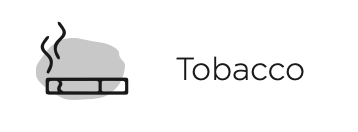Tempranillo
- Red grape used to make Rioja red wines.
- Wines are dry, fruity and medium to full-bodied.
- Most wines are aged in oak barrels, followed by bottle ageing before going on sale.
Intro
- Tempranillo grape is originally from Spain and is the most planted grape in Spain.
- The name Tempranillo comes from the Spanish word “temprano” (early), as these grapes ripen several weeks earlier than most Spanish red grapes.
- Rioja is the most well-known region for Tempranillo.
Aromas & Flavours
- Tempranillo from the Rioja region is known for its red fruit aromas and flavours like strawberry and plum. These wines are aged in oak barrels.
- Ageing wine in oak barrels softens the tannins and adds notes of sweet flavours like vanilla or coconut.
- With age, the wines can also show vegetable notes such as mushrooms or even animal notes like meat or leather.
Different styles of Tempranillo wines to try
Ageing
There are four different styles of Tempranillo wines depending on their ageing process. The styles, starting with the youngest to oldest are:
- Joven
- Crianza
- Reserva
- Gran Reserva
- Joven wines are young, fresh and fruity wines which are ready to be consumed right away, ideally within 1 year. They tend to cost around €10 per bottle, unless you are in Spain, where the same wine will cost you €4.
- Crianza wines are aged for 2 years and are easy to drink wines. They often give a sweet sensation of ripe berry fruits and toasty notes. They tend to cost around €12-€15.
- Reserva wines are aged for 3 years. These wines tend to be high quality with rich, intense and expressive aromas such as ripe berries, cinnamon, black pepper and liquorice. They tend to cost around €20-€25.
- Gran Reserva – outstanding flavours, these wines are aged for a minimum of five years. These wines are complex, with intense aromas and spice notes. They tend to cost around €30 per bottle.
The wine ageing takes place in the winery, so when you see a Rioja in a wine shop it is always ready to drink. Older wines like Reserva and Gran Reserva can be kept at home and aged for longer, in some cases up to 20 years.
Region
You can also find different types of Tempranillo, depending on the region, e.g.:
- Rioja
- Ribera del Duero
- Penedes
Rioja:
- Rioja makes white and red wine, but the most well-known wines internationally are their red wines, made with Tempranillo and blended with
- These wines tend to be medium to full-bodied dry wines, with medium acidity and medium tannins with red fruit aromas and flavours like strawberry and plum.
- Find out more: www.riojawine.com
Ribera del Duero:
- Tempranillo from the Ribera del Duero tend to have black fruit notes like blackberry and plum, and toasted flavours.
- Find out more (site in Spanish): www.riberadelduero.es
Catalunya
- Ull de llebre (Tempranillo grape in Catalan) from the Penedès region or the Costers del Segre
- Penedes wines tend to be aromatic with red fruit notes like cherry.
- There are also different styles of wine depending on their ageing time.
- Find out more: www.dopenedes.cat
FOOD pAIRING
Tempranillo is a food-friendly wine. An obvious food pairing option would be to match the wine with Spanish food, like:
- tapas: aged manchego cheese (hard sheep cheese), chorizo, tortilla de patatas
- bean casseroles
- grilled or roast meat
Wine serving temperature
- Room temperature, around 16°C – 18°C
Similar wine grape varieties
- Cabernet Sauvignon
- Sangiovese
Grape variety also known as
Tempranillo grape name changes depending on the country and region, e.g.:
- Ull de Llebre in Catalonia which translates literally to “hare’s eye”
- Tinto Fino in Ribera del Duero wine region in Spain
- Tinto Roriz or Aragonez in Portugal









